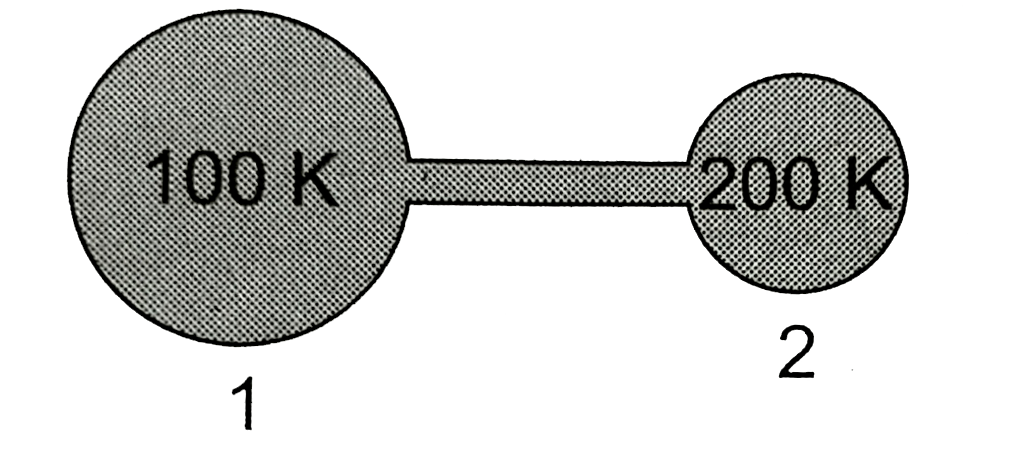Figure shows two flasks connected to each other. The volume of the flask 1 is twice that of flask 2. The system is filled with an ideal gas at temperature 100K and 200K respectively. If the mass of the gas in 1 be m then what is the mass of the gas in flask 2
 Solution in Gujrati
Solution in Gujrati
m
m2
m4
m8
The correct Answer is:C
Step by step video & image solution for Figure shows two flasks connected to each other. The volume of the flask 1 is twice that of flask 2. The system is filled with an ideal gas at temperature 100 K and 200 K respectively. If the mass of the gas in 1 be m then what is the mass of the gas in flask 2 by Physics experts to help you in doubts & scoring excellent marks in Class 12 exams.
Updated on:21/07/2023Topper's Solved these Questions
- RACEBOOK - ALLEN CHAPTER - RACEEXERCISE - Basic Maths (Thermal Physics) (Thermodynamic process)
20 Videos
- RACEBOOK - ALLEN CHAPTER - RACEEXERCISE - Basic Maths (Dscillations) (Kinematics of SHM)
20 Videos
- RACEBOOK - ALLEN CHAPTER - RACEEXERCISE - Basic Maths (Thermal Physics) (Mode of Heat Transfer)
15 Videos
- NEWTONS LAWS OF MOTIONBOOK - ALLEN CHAPTER - NEWTONS LAWS OF MOTIONEXERCISE - EXERCISE-III
28 Videos
- SIMPLE HARMONIC MOTIONBOOK - ALLEN CHAPTER - SIMPLE HARMONIC MOTIONEXERCISE - Example
1 Videos
Similar Questions
The pressure and volume of gas are changed as shown in the P-V diagram in the figure ahead. The temperature of the gas :

View SolutionTwo particles executing SHM of same frequency meet at x=+√3A2, while moving in opposite directions. Phase difference between the particles is :-
View SolutionThree identical rods have been joined at a junction to make it a Y shape structure. If two free ends are maintained at 60∘C and the third end is at 0∘C, then what is the junction temperature θ ?

View SolutionAssertion: The driver in a vechicle moving with a constant speed on a straight road is in a non-inertial frame of referance.
Reason: A reference frame in which Newton's laws of motion are applicable is non-inertial.
View SolutionA rod with rectangular cross section oscillates about a horizontal axis passing through one of its ends and it behaves like a seconds pendulum, its length will be
View SolutionA flask is filled with 13g of an ideal gas at 27∘C and its temperature is raised to 52∘C. The mass of the gas that has to be released to maintain the temperature of the gas in the flask at 52∘C, the pressure remaining the same is
View SolutionFigure shows two flasks connected to each other. The volume of the flask 1 is twice that of flask 2. The system is filled with an ideal gas at temperature 100K and 200K respectively. If the mass of the gas in 1 be m then what is the mass of the gas in flask 2

View SolutionTwo flask A and B of equal volumes maintained at temperature 300K and 700K contain equal mass of He(g) and N_(2)(g) respectively. What is the ratio of total translational kinetic energy of gas in flask A to that of flask B ?
View SolutionA 100 mL flask contained H_(2) at 200 Torr, and a 200 mL flask contained He at 100 Torr. The two flask were then connected so that each gas filled their combined volume. Assuming no change in temperature,total pressure is
View SolutionTwo flasks of equal volume are connected by a narrow tube of negligible volume and are filled with N_(2) gas. When both the flasks are immersed in boiling water the gas pressure inside the system is 0.5 atm. Calculate the pressure of the system when one of the flasks is immersed in ice water while the other flask in boiling water.
View SolutionA flask of volume 1L contains 1 mol of an ideal gas. The flask is connected to an evacuated flask, and as a result the volume of the gas becomes 10 L. the change in entropy (J*K^(-1)) of the gas is this process is-
View SolutionA flask is filled with 1.3 g of an ideal gas at 27∘C and its temperature is raised to 52∘C. The mass of the gas that has to be released to maintain the temperature of the gas in the flask at 52∘C and the pressure remaining the same is
View SolutionTwo flasks A and B of 1L each are filled with O_(2) and SO_(2) gas at 27^(@) C and 1 atm pressure. The flasks will contain .
View SolutionA flask is filled with 13 g of an ideal gas at 27^(@)C and its temperature is raised to 52^(@)C . Find the mass of the gas that has to be released to maintain the temperature of the gas in the flask at 52^(@)C and the pressure is same as the initial pressure.
View SolutionA flask of 1L volume contains a standard gas amounting to 1mol. The flask is combined with a zero flask, so the volume of the gas is 10L Changes in the entropy of the gas in the process ( JK^-1 ) —
View SolutionTwo flask A and B of equal volumes maintained at temperature 300K and 700K contain equal mass of He(g) and N2(g) respectively. What is the ratio of total translational kinetic energy of gas in flask A to that of flask B ?
View Solution
